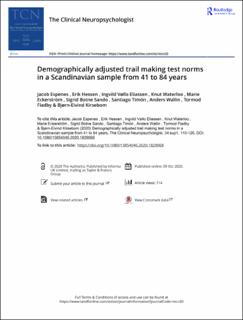| dc.contributor.author | Espenes, Johan Jacob | |
| dc.contributor.author | Hessen, Erik | |
| dc.contributor.author | Eliassen, Ingvild Vøllo | |
| dc.contributor.author | Waterloo, Knut | |
| dc.contributor.author | Eckerström, Marie | |
| dc.contributor.author | Sando, Sigrid Botne | |
| dc.contributor.author | Timón, Santiago | |
| dc.contributor.author | Wallin, Anders | |
| dc.contributor.author | Fladby, Tormod | |
| dc.contributor.author | Kirsebom, Bjørn-Eivind | |
| dc.date.accessioned | 2021-02-09T14:14:07Z | |
| dc.date.available | 2021-02-09T14:14:07Z | |
| dc.date.created | 2020-10-23T12:55:04Z | |
| dc.date.issued | 2020 | |
| dc.identifier.citation | The Clinical Neuropsychologist. 2020, 34, sup. 1, 1-18. | en_US |
| dc.identifier.issn | 1385-4046 | |
| dc.identifier.uri | https://hdl.handle.net/11250/2726957 | |
| dc.description.abstract | Objective
The trail making test (TMT) is one of the most widely used neuropsychological tests. TMT-A provides measures of visual scanning/visuomotor speed and TMT-B involves additional demands on executive functions. Derived scores TMT B-A and TMT B/A enhance measures of executive functioning. However, simple B-A subtraction may lead to false estimates of executive dysfunction in clinical samples. Norms for TMT have been published in several countries but are currently lacking for Scandinavia.
Methods
A total of 292 healthy controls between age 41 and 84 years were included from the Norwegian “Dementia Disease Initiation” (DDI) study (n = 170) and the Gothenburg Mild Cognitive Impairment (MCI) study (n = 122). We used a regression-based procedure to develop demographically adjusted norms for basic (TMT-A and TMT-B) and derived measures (TMT B-A and B/A). We also propose a regression-based alternative to the TMT B-A measure named “TMT-β”. The proposed norms were compared to norms from Heaton et al. and Tombaugh.
Results
Due to differences in the estimated normative effects of demographics on performance, the proposed norms for TMT were better suited in the Scandinavian sample compared with published non-Scandinavian norms. The proposed TMT-β measure was highly correlated to TMT B-A (r = 0.969, p < 0.001).
Conclusion
We here propose demographically adjusted norms for the TMT for ages 41 through 84 years based on a Scandinavian sample. We also present the regression-based derived measure TMT-β which may resolve issues with the conventional TMT B-A measure. | en_US |
| dc.language.iso | eng | en_US |
| dc.publisher | Informa UK Limited, trading as Taylor & Francis Group. | en_US |
| dc.rights | Attribution-NonCommercial-NoDerivatives 4.0 Internasjonal | * |
| dc.rights.uri | http://creativecommons.org/licenses/by-nc-nd/4.0/deed.no | * |
| dc.title | Demographically adjusted trail making test norms in a Scandinavian sample from 41 to 84 years | en_US |
| dc.type | Peer reviewed | en_US |
| dc.type | Journal article | en_US |
| dc.description.version | publishedVersion | en_US |
| dc.source.pagenumber | 1-18 | en_US |
| dc.source.volume | 34 sup. 1 | en_US |
| dc.source.journal | The Clinical Neuropsychologist | en_US |
| dc.identifier.doi | 10.1080/13854046.2020.1829068 | |
| dc.identifier.cristin | 1841804 | |
| dc.description.localcode | © 2020 The Author(s). Published by Informa UK Limited, trading as Taylor & Francis Group This is an Open Access article distributed under the terms of the Creative Commons Attribution-NonCommercial-NoDerivatives License (http://creativecommons.org/licenses/by-nc-nd/4.0/), which permits non-commercial re-use, distribution, and reproduction in any medium, provided the original work is properly cited, and is not altered, transformed, or built upon in any way. | en_US |
| cristin.ispublished | true | |
| cristin.fulltext | original | |
| cristin.qualitycode | 1 | |

